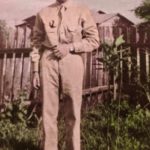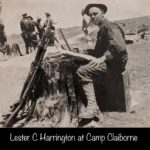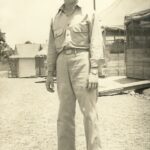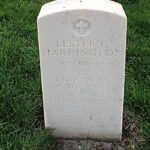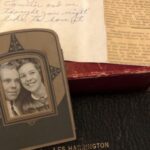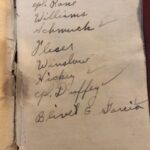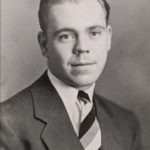Ranger Lester C Harrington

SGT Lester C Harrington
Born: 28 June 1920 Silver Creek, Nebraska
Died: 30 November 1943 Venafro, Italy Killed in Action
Army Serial Number: 20708518
Ranger Battalion/Company: 1/D
Rank: SGT
Enlisted: 25 September 1939 Minnesota National Guard
Battles/Campaigns/Significants: (Operation Torch)Arzew,Algeria, Gafsa, Sened Station & El Guettar in Tunisia, (Operation Husky)Gela, Butera, Sicily, Salerno, Maiori, Chiunzi Pass, Venafro, Italy
Medals/Awards: CIB, BSM, EAME Campaign Medal, WWII Victory Medal, American Defense Medal, Purple Heart, 2 Presidental Unit Citations-El Guettar (WD GO 56, 1944) & Salerno (WD GO 41, 1947)
Biography
Lester C Harrington was born in the area of Silver Creek, Nebraska. He was the son of Milo Elsworth Harrington and Nancy Eliza Wells. Milo or “Mike” was a veteran of WWI serving as a PVT in Supply CO 354th Infantry he served over a year. Mike supported his family as a farmer in Silver Creek, Nebraska in 1920. Lester was the eldest of the 6 Harrington children. Through the years they moved several times and finally settled down in Columbus, Wisconsin.
At the age of 19 on 25 September 1939 Lester signed up with the National Guard in Minnesota. This was the 135th Infantry Regiment “To The Last Man”, 34th Division “The Red Bulls”. On 14 January 1941 a Presidential Executive Order 8633 was issued directing all elements of the 34th Division as of 10 February 1941 activated for federal service the next 12 months. The units entrained and headed for Camp Clariborne in Louisiana on 25 February 1941 as the temps dipped down to 20 degrees below zero. Crowds of well wishers, veterans and bands gathered at the various stations in the freezing cold to see these men off to war.
Lester and his fellow soldiers arrived at Camp Clairborne on 27 February 1941. They were marched into an ungraded and eroded camp site that resembled a sea of mud. The troops set up pyramidal tents and started training immediately. The unit was still training at the camp when the Japanese attacked Pearl Harbor on 7 December 1941 The next day war was declared and by 9 December the units had cleared out of Clairborne headed for defensive southern coastal positions. The Red Bulls were relieved of that duty on 1 January 1942 and headed back to Camp Clairborne. 8 January they again cleared the camp and entrained for Fort Dix in New Jersey. They arrived at the Fort on the 11th of January. Preparations were made to board ships for Belfast, Northern Ireland.
On January 15, 1942, ships of convoy AT-10 left the Brooklyn Army Terminal to make the journey across the Atlantic. Aboard the transports USS Chateau Thierry and HMTS Strathaird were mostly soldiers of the 34th Infantry Division, aka “Red Bull,” 4,058 in all. Codenamed Operation Magnet, this was the first deployment of American combat troops to foreign soil after the US officially entered World War II. At 10am that day, they set sail with a large convoy including this was not a triumphant departure. Soldiers were ordered below decks as the ships departed to maintain some semblance of secrecy, though “the secret seemed to be more closely kept from the troops themselves than it was from the general public, for around the bars and restaurants of New York, talk had the 34th destined for Belfast, Ireland.” During this time the German U-boats were crusing the seas looking for allied ships. Luckily, U-123 did not cross paths with AT-10, but there was a massive flotilla of ships deployed to protect this convoy – 17 destroyers (out of 21 total on the Atlantic coast), three cruisers, battleship USS Texas, and aircraft carrier USS Wasp. While free from U-boat attacks (though two unknown sonar contacts were made and depth charges dropped), the journey was still a rocky one across the North Atlantic in the dead of winter. The 34th’s history complains especially of the food aboard the British Strathaird: “The men grew ill by the hundreds on the English diet of constant fish and mutton, augmented by the illness of the sea.”
The initial group of 4,508 men stepped ashore at 12:15 hrs on 26 January 1942 at Dufferin Quay, Belfast, Northern Ireland. They were met by a delegation including the Governor (Duke of Abercorn), the Prime Minister (John Miller Andrews), The Commander of British Troops (Lieutenant General Sir Harold Franklyn), and the Secretary of State For Air (Sir Archibald Sinclair). While in Northern Ireland, Hartle was tasked with organizing an American version of the British Commandoes, a group of small "hit and run" forces, and promoted his aide,Captain William Orlando Darby to lead the new unit Darby assembled volunteers, and of the first 500 US Army Rangers, 281 came from the 34th Infantry Division.
Lester and the other 280 135th Infantry Regt 34th Division volunteers would be interviewed and transported to Carrickfergus, Northern Ireland to Sunnyland Camp. Darby and his team of Officers were tasked with interviews to evaluate the approximately 1500 men from various units. After a period of time there were 515 men enlisted men and officers picked to become the 1st Ranger Battalion as of 19 June 1942. The men were moved to Archnacarry in Northern Scotland. The new Rangers would be put thru their training lead by British Commando Officers. The Rangers were made up of 7 Companies HQ, A,B,C,D,E,F. There were 6 line Companies D Company consisted of 69 enlisted men and 3 Officers. Lester was assigned to D Company of the 1st Ranger Battalion. Captain Alvah M Miller was the first CO of D Company.
CPL Harrington was promoted to a SGT while the Rangers were in Nemours, Algeria, North Africa on 19 June 1943. Ranger Harrington fought with 1st Rangers D Co at Gela in Sicily on 10 July 1943. During that time the 3rd Rangers were making a landing at Licata. After the 1st & 4th moved across Sicily, the 3rd Rangers joined them and took a brief period to train and add more troops while in Corleone, Sicily. All three Battalions would be involved with the next operation.
On 7 Sept D traveled to Palermo and boarded LCI 232 to make the Salerno landings at Maiori, Italy. 4th Rangers made quick work at clearing the beaches and inland. All 3 Ranger Battalions moved farther inland and up hill to Mt St Angelo to hold Chiunzi Pass. This was a time when Shunstrom’s 4 halftracs in Cannon Company became very useful to keep the enemies at bay. Rangers had to dig holes in the steep sides along the roadway for cover. There was a command station and Captain Emile Shuster set up caring for the wounded in a stone building at the top of the pass. It became known as “Fort Shuster.”The 1st Rangers earned a Presidential Unit Citation for El Guettar and they earned another after the Salerno Landing at Chiunzi Pass. SGT Harrington participated in the Chiunzi Pass, Mt St Angelo area. This would make the Rangers third invasion and they were moved to Naples at the botanical gardens and set up pup tents in the area. The Rangers were angry with Darby because they wanted to stay in the buildings abandoned by the Germans. They quickly became grateful when the timed mines started blowing up inside the building. After the building were checked by engineers and more mines were removed they were able to move into the housing. Darby let the men have a celebration and the beer and wine was consumed.
On 8 November 1943 the 1st Rangers loaded into trucks and took a two hour ride to the Venafro area. The fighting took place high in the mountains in Venafro. Rangers dealt with an extremely cold winter with many suffering from frostbite or trenchfoot. The ground was frozen and there was not very cover. The Germans had set mines and there were snipers trying to pick off the Rangers because of little cover. This was the first time the Rangers had been used for line line infantry troops. The Rangers were not used to this type of warfare. They were small companies set up as nighttime strike units. Ranger Harrington celebrated Thanksgiving with all the fixins in the mountains it would be his last for he was was unfortunately killed in action on 30 November 1943 along with two other D Company men. The 1st Ranger Battalion continued fighting until they were relieved on 15 December and were trucked 120 miles to Lucrino, Italy.
SGT Lester C Harrington was reinterred in the Keokuk National Cemetery in Keokuk, Iowa.
